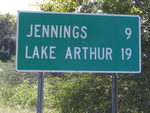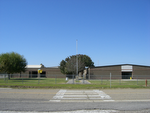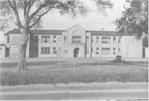Updated December 29, 2009
Teaching in the Days of Old
One of the most interesting aspects of the school days of old is the fact that children were not required to enroll in school. The compulsory education act did not become law in Louisiana until 1916. Then, children between the ages of 8 to 14 were required to attend at least 140 days of school. The compulsory education law was expanded in 1945 to children between 6 to 16, requiring them to attend the full school year.
Edith Blackshire was a young teacher who taught at Glen Roy and Grand Marais in the first few years of the 20th Century. Her roll book from the years 1903 and 1904 is in a Jeff Davis Parish archive. In that year, she was a 24 year old seasoned schoolhouse teacher. She had moved with her family from Iowa as a young woman. Her roll book is sure evidence of how difficult it must have been to teach in those days. The fact that she had many children at all different levels must have been hard enough. But because attendance was not compulsory, there were so many children with sporadic attendance. The chore it must have been to keep up with who was where in their studies.
In addition to attendance issues, many teachers also faced language barriers, if they did not speak French. Many children did not speak English, which must have made teaching quite a challenge. Notes from a young teacher who was just starting out in a neighboring ward reported how difficult it was to gain control of her classroom. She remembers having to act like she understood French to keep children in check.
And the final obstacle that a schoolhouse teacher had to overcome was the respect of her students. She had to run a firm classroom, which often involved discipline. The same young teacher as mentioned above recounted how she finally quashed the chaos of her first few weeks and got her student's attention. One day, two boys couldnot be controlled and their disrespect brought the teacher to a point of action. She had had it. She whipped the boys in the cloak room with their own belts. Her troubles were over immediately.
In those days, children learned to read, write, add and subtract much the same as children today. They had classes in Arithmetic, both mental and written, History, Geography, Language, Writing, Drafting, Health. Ms. Blackshire's roll book contained references to the books she used to teach her classes, which included the following:
- Elementary Arithmetic by Nicholson (a professor at LSU)
- New Complete Geography by Maury
- Our Bodies and How We Live by Blaisdell
A Day in the Life of a Student
A typical day for students of a schoolhouse in Hathaway began at 5 a.m. In most homes, children had chores to do before they left for school. They might have to milk cows for the day's milk, feed the hogs and chickens, or pick vegetables from the garden and figs and other fruit from the trees. Children in the school-house days left for school by foot or horseback. Some rode a buggy pulled by a horse. Larger families traveled by wagon. If there was room, children walking the same path were given a ride. Roads or trails traveled by wagon were made of dirt that muddied up after a rain and dried with deep ruts. The ride was a bumpy one.
Arriving at school early was always fun. Ms. Effie Compton Talley, who attended the Raymond school, recalls her always wanting to get to school early to play with the other kids. She and her friends' favorite game was to walk the rails of the wooden fence that surrounded the school. Recess has always been a child's favorite. A school day had recess three times a day. Mid-morning and mid-afternoon there was a 15-minute recess, and at Noon, there was an hour-long recess. The shorter recesses did not leave much time for games. But the hour recess was when the older children played baseball and the younger children played group games involving someone who was "It." Ms. Lois Gary, who attended the Grand Marais school, remembers her favorite games at recess were playing checkers or hop scotch, jumping rope, playing croquet or dodge ball, and for the longer recess, they played baseball. Sometimes balls were hard to come by. If they had to, they could make one by wrapping twine around a rock, then wrap a sewn cover over the twine ball.
When the time came for classes to begin, usually 9 a.m., the teacher or an older student would ring a bell a few minutes before class began to give students time to finish their games, come inside and prepare for their lesson. The school day began with the Pledge of Allegiance or singing a patriotic song like "America The Beautiful" or "The Star Spangled Banner." Then, the children usually had a unique activity planned by the teacher. Sometimes the teacher simply read a bit from a good book or other times the children played a quite game. Whatever activity they played, there was occassionally a surprise that students would not want to miss. The teacher tried to create some mystery in her activities to entice children to arrive to school on time.
The "3 R's" dominated the curriculum of the day: "Reading, 'Riting, and 'Rithmetic." And, as noted above, teaching revolved around the fourth "R": Recitation. Typically, the first class of the day for younger children was Reading. Students from each grade went to the front of the classroom and sat on the bench; then they were asked to recite from their grade level's reader. For example, one class would be assigned a story or poem to read and then be required to stand up and recite a passage or stanza from memory. Another class would be assigned a story to read at their desk and when it was time to recite, the student would have to select a passage they thought carried the meaning of the story, then stand up and read it and explain why they chose that passage. Each class usually had about 10 minutes at the recitation bench, so students had to be diligent and concise. When the younger students were through their recitations, they were usually released for the fifth "R": Recess. While the younger children recited from the bench, older children were preparing for morning Arithmetic recitation before the morning recess.
After recess, the younger students came back inside to an Arithmetic problem for their grade on the board. The problem was usually in the form of a story, and typically involved a problem they might encounter on the farm. The recitation bench was an important feature in this class too. After being given some time to complete the problem, students were called to the bench and their work was discussed.
While students were reciting, other students may be working through math problems at the blackboard or working through their classes' problem in their seat. The captive audience of the student reciting was usually just his teacher and his classmates at the bench. Everyone else had their own work to do. While the younger children were doing Arithmetic problems, the older students were preparing for their Reading recitation. If the school had teenaged students, they studied courses like Elementary Agriculture or Geography. When all the classes had gone through their work, the Noon hour was upon them and it was time for lunch. The break during lunch was an hour. That meant that the longer it took to eat, the less time there was to play, so food was scarfed and play outside was underway in minutes. Lunch also included time for play.
 Until the school houses were consolidated at Hathaway, lunch was not served at school. Children brought their own food. When the school houses were consolidated at Hathaway, soup was available for a nickel for those children who did not bring their lunch. Mothers regularly would send well more food than her child could eat, which meant sharing was inevitable. Children also came with what was available at their house. And this was likely what was in their lunch pale every day, so bartering for variety was quite common.
Until the school houses were consolidated at Hathaway, lunch was not served at school. Children brought their own food. When the school houses were consolidated at Hathaway, soup was available for a nickel for those children who did not bring their lunch. Mothers regularly would send well more food than her child could eat, which meant sharing was inevitable. Children also came with what was available at their house. And this was likely what was in their lunch pale every day, so bartering for variety was quite common.
A typical lunch could include, for example, leftovers such as rice and gravy or rice and beans from dinner the night before, or it could be a biscuit and sausage sandwich with a cookie or fig preserves for dessert. Children ususally came to school with a tin pale containing their lunch. Later, children brought their lunch in a paper bag. For the children who rode horses to school or drove a buggy (below) or wagon, lunch included feeding their horses.
When students were called back inside by the bell, the afternoon session began with another activity, such as singing a song. When class was back in session, the focus was on Language: Grammar, Penmanship, and Spelling. Grammar often involved a lecture to several classes at once. Older students and teenaged students had studies in literature. Recitation was still common though, and more so than recitations in reading in arithmetic, students could learn by listening to these recitations.
Penmanship made an important impression on others, and practice made perfect. Most desks had a hole in the desk where an ink well would sit for students to dip their pen to write their letters. Slates were also used for practice. Chalk was common in the classroom about 1900; before that slate pens were used.
Spelling lessons involved a list from a book for that grade. Students had to memorize the words and spell them in a spelling bee-type game that crowned a "Head Mark." The game had students line up on the bench. Each student was given a word to spell from the list. If the spelling was missed, the next student had an opportunity to spell the word. If that student spelled the word correctly, the student who missed the word traded positions on the bench. The game played on until there was a "Head Mark" (the winner, who had the honor of starting the next spelling bee in the last position on the bench).
Often, the whole class then pulled out their drawing pads, or practiced their penmanship by writing a letter. The younger students ended their day with another Reading session. When the younger students finished their "3 R's," usually they were released for the day. Older students though stayed for another hour or so for other upper-level classes like Health, Nature Study, etc. Some younger students stayed around and played outside, waiting on their older sibling for the walk home.
School life for older students also included participation in various clubs. Much like today’s 4-H Club, students were invited to participate in clubs such as the Pig, Corn, Tomato, or Poultry clubs. And much like 4-H today, students competed on a parish-wide level representing their school. For example, in 1914 the student with the best pig in the parish won $15. 4-H Clubs came to Hathaway in 1942 through the parish extension service.
When school ended around 4 p.m., the children walked home with a sibling or neighbor or mounted their horses and wagons and headed home. For young children, mounting a horse was not always easy. Ms. Talley remembers she and her sister having to hop from the water trough. Others used the fence.





No comments:
Post a Comment